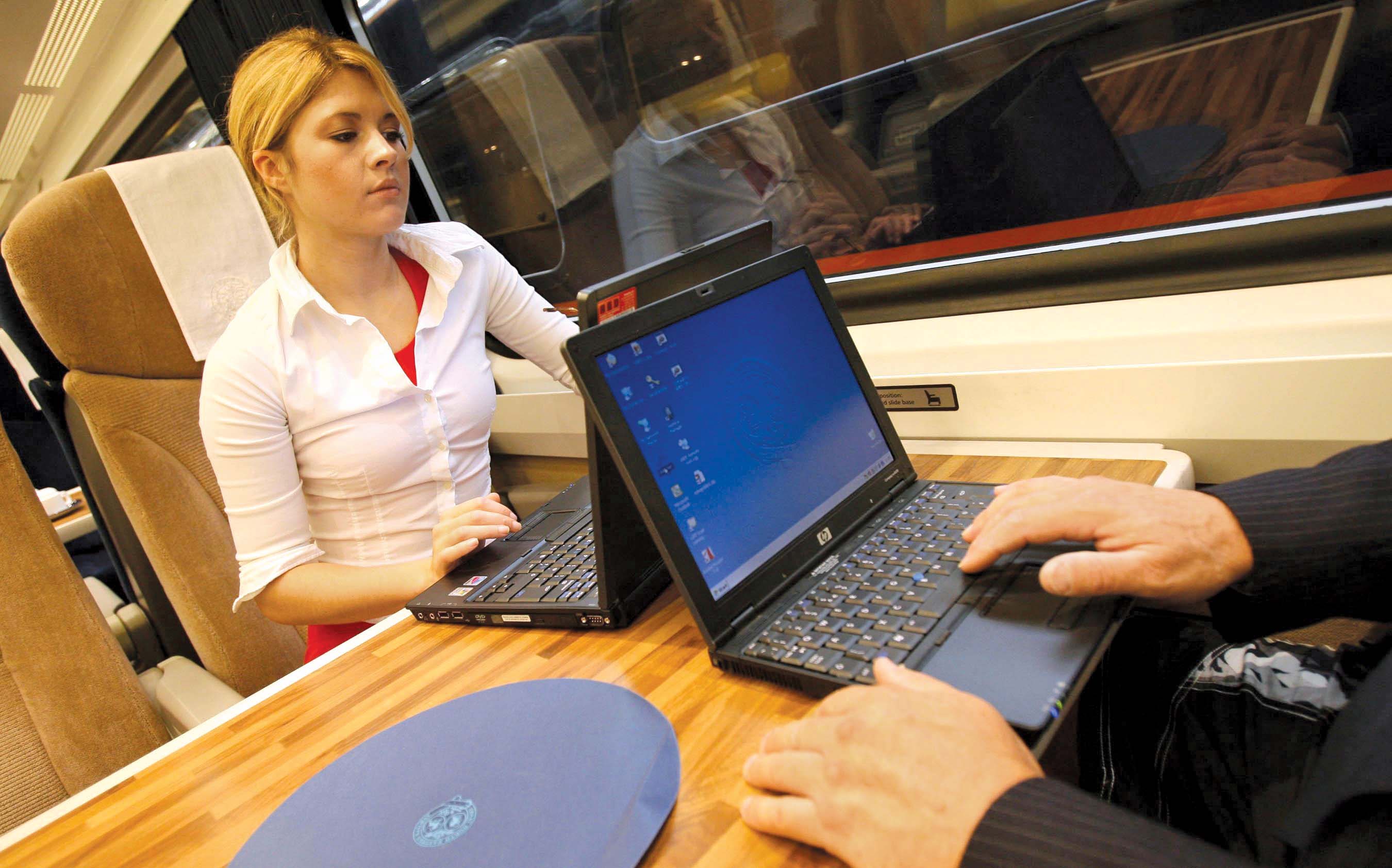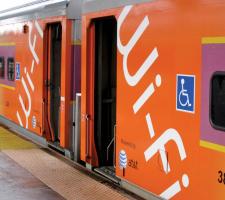
Does working on a train effectively ‘reduce’ travel time
The ‘value of time’ concept can be a vital decider in prioritising transport projects, as Lorenzo Casullo and Serbjeet Kohli of Steer Davies Gleave explain.
How much do travellers value their time and how much would they be willing to pay for a better and faster transport option? For many years801 Steer Davies Gleave (SDG) has been collecting this type of information from thousands of people across the world as it researches travellers’ behaviour. And given the importance of this parameter for transport modelling and research, value of time is a useful tool for policy-makers faced with decisions about transport funding and investment.
When needing to get from A to B every traveller, whether they are delivering goods, commuting to work or going on holiday, has a range of transport options and makes choices based on the relative cost and the speed, comfort and reliability of each option. Likewise, when evaluating proposed projects that require funding decisions, transport planners need a uniform and reliable metric to assess the benefits to transport users of each option.
The process of collecting information about users’ preferences and converting that into meaningful parameters for decision-making is therefore crucial for effective transport planning. Value of time in particular is a key input for transport models and cost-benefit analyses, and is usually shown as one unit of local currency per one unit of time – such as $/hour.
In transport models, value of time represents the trade-off between time and money for users making the choice about which mode of transport to use for a particular journey – be that a one-off or regular commute. Strictly speaking, value of time used in transport models is the subjective or behavioural ‘Value of Travel Time Savings’ of users within the specific choice context. In business case appraisals value of time is used to measure and convert the benefits of planned transport investment into monetary units that can be used in the overall assessment of costs and benefits.
The use of location-specific and context-specific values of time provide the best information for any single-mode project but to allow comparisons between modes or from one project to the next, government authorities may wish to specify which values and parameters are evaluated.
With proposed transport investment, the value of time can be extrapolated from dedicated surveys in which potential users of the new infrastructure are asked to express their choices in relation to hypothetical alternative ways of travelling, under varying conditions. After collecting and processing the data, SDG uses analytical models to estimate monetary results for different types of users – commuters, business travellers, mass transit, trucking companies and the like. This work typically relies on stated preference techniques which use a probabilistic choice model to derive the value of time parameter from the survey data collected.
The segmentation of users is an important step in this process, since it captures the differences in subjective value of time, depending on factors such as purpose of travel, income, length of journey and other, sometimes location-specific, characteristics. This is why the stated preference surveys also collect additional information about the socio-economic background of travellers being interviewed, the reason for their journey and the frequency of their travel.
By way of example, an estimated time saving on a highway (say 15 minutes) will be valued differently by travellers depending on the urgency of their journey. For instance travellers running late for an important meeting would be willing to pay more to cut their journey times than one who is in no particular hurry. On the other hand the additional costs of using a faster but tolled alternative to make a timed delivery may mean the delivery company makes a loss on the job.
So each traveller places a different value on time depending on their circumstances and this will change from one day to the next. Therefore in the case of a busy highway, it is likely that at any given time some travellers will be caught in these urgent situations. So introducing a traffic management system to provide a fast lane at peak time may be an option to consider – particularly if road capacity is due to be expanded.
Thanks to the development of real-time technologies, managed lanes such as express and high occupancy Toll lanes, have come into the transport planners’ focus, particularly in the US, as one solution to optimise highway capacity. A thorough analysis of value of time is useful to assess when and where to introduce managed lanes, as well as to map the travel characteristics of potential managed lane users.
Recent evidence gained from observing user behaviour on managed lanes in America has shown responses which from a pure ‘time versus cost saving’ argument, initially appear counter-intuitive. In these observations the use of managed lanes increased as the toll rates went up - a sign that the users are relating higher tolls on the managed lanes to higher time savings.
Another example of the interrelation between the value of time savings and technology has emerged from a review of business travel recently undertaken by the UK’s1837 Department for Transport. This raised fundamental questions about the productivity of workers during rail journeys. Would a time saving introduced by faster rail links such as high speed rail be valued differently by people who work while travelling on trains? And conversely, does the introduction of better ‘working stations’, including desks and wireless internet, on trains alter travellers’ perceptions of journey length? Such questions on productivity can only be answered by reassessing the way economic benefits are calculated in light of technological innovation.
Estimating value of time through fieldwork provides more accurate results than simply carrying out a literature review to make assumptions about people’s values. In several countries, such literature would not even exist and further assumptions would need to be made by looking at international data.
Although traveller profile and preferences are different in each country and for each project, SDG consolidates the international experience in order to observe historical trends and evaluate differences of users’ behaviour across geographies and context. By analysing the available data, a number of questions can be addressed such as: Does value of time grow in line with incomes, how do commuters value time in comparison with other travellers, and how much are heavy vehicles willing to pay in relation to cars?
Beyond shedding light on the characteristics of the transport market, such surveys also provides complementary information such as the socio-demographic profile of travellers, which is also valuable to decision-makers.
The surveys can also reveal users’ preference towards the introduction of real time information systems on public transport stops and stations. As these systems are now becoming ubiquitous SDG is increasingly involved in the assessment of people’s preferences in relation to new technological improvements and innovations.
In the past few months SDG has been working with1466 Transport for London to assess cyclists’ attitude towards new docking stations, types of bicycles and online reservation systems of the city’s cycle hire scheme. SDG is also working with the municipality of Bogotá to evaluate the social, economic and environmental impacts of a congestion charging scheme for the capital of Colombia, as well as assessing different technologies that might be required as part of the monitoring strategy.
Due to the plethora of variables, location- and context-specific value of time estimates are key inputs in developing accurate models for the decision-making process. It is also important that value of time is estimated in a consistent and transparent manner so that, when different projects are compared, underlying methodological differences in value of time do not affect the overall assessment of competing solutions.
Lorenzo Casullo is economist at Steer Davies Gleave and Serbjeet Kohli is one of the company’s Associates. They are both based in London and work on a range of projects across the world.
How much do travellers value their time and how much would they be willing to pay for a better and faster transport option? For many years
When needing to get from A to B every traveller, whether they are delivering goods, commuting to work or going on holiday, has a range of transport options and makes choices based on the relative cost and the speed, comfort and reliability of each option. Likewise, when evaluating proposed projects that require funding decisions, transport planners need a uniform and reliable metric to assess the benefits to transport users of each option.
The process of collecting information about users’ preferences and converting that into meaningful parameters for decision-making is therefore crucial for effective transport planning. Value of time in particular is a key input for transport models and cost-benefit analyses, and is usually shown as one unit of local currency per one unit of time – such as $/hour.
In transport models, value of time represents the trade-off between time and money for users making the choice about which mode of transport to use for a particular journey – be that a one-off or regular commute. Strictly speaking, value of time used in transport models is the subjective or behavioural ‘Value of Travel Time Savings’ of users within the specific choice context. In business case appraisals value of time is used to measure and convert the benefits of planned transport investment into monetary units that can be used in the overall assessment of costs and benefits.
The use of location-specific and context-specific values of time provide the best information for any single-mode project but to allow comparisons between modes or from one project to the next, government authorities may wish to specify which values and parameters are evaluated.
Calculating the value of time
Estimating value of time typically takes a few weeks, depending on the type of transport project and the methods chosen. In the case of existing transport infrastructure the relevant trade-offs between costs and travel time savings can be revealed by observing users’ preferences. This typically requires site surveys and travellers counts.With proposed transport investment, the value of time can be extrapolated from dedicated surveys in which potential users of the new infrastructure are asked to express their choices in relation to hypothetical alternative ways of travelling, under varying conditions. After collecting and processing the data, SDG uses analytical models to estimate monetary results for different types of users – commuters, business travellers, mass transit, trucking companies and the like. This work typically relies on stated preference techniques which use a probabilistic choice model to derive the value of time parameter from the survey data collected.
The segmentation of users is an important step in this process, since it captures the differences in subjective value of time, depending on factors such as purpose of travel, income, length of journey and other, sometimes location-specific, characteristics. This is why the stated preference surveys also collect additional information about the socio-economic background of travellers being interviewed, the reason for their journey and the frequency of their travel.
Valuing ITS solutions
Transport planners are increasingly evaluating ITS solutions to maximise the efficiency of transport networks, secure their financial viability and tackle problems such as congestion. The question is, however, how best can decision-makers prioritise funding to different ITS solutions? Governments and local authorities will certainly be better equipped to make good decisions if they can rely on accurate and up-to-date valuations of the time savings that each solution may provide.By way of example, an estimated time saving on a highway (say 15 minutes) will be valued differently by travellers depending on the urgency of their journey. For instance travellers running late for an important meeting would be willing to pay more to cut their journey times than one who is in no particular hurry. On the other hand the additional costs of using a faster but tolled alternative to make a timed delivery may mean the delivery company makes a loss on the job.
So each traveller places a different value on time depending on their circumstances and this will change from one day to the next. Therefore in the case of a busy highway, it is likely that at any given time some travellers will be caught in these urgent situations. So introducing a traffic management system to provide a fast lane at peak time may be an option to consider – particularly if road capacity is due to be expanded.
Thanks to the development of real-time technologies, managed lanes such as express and high occupancy Toll lanes, have come into the transport planners’ focus, particularly in the US, as one solution to optimise highway capacity. A thorough analysis of value of time is useful to assess when and where to introduce managed lanes, as well as to map the travel characteristics of potential managed lane users.
Recent evidence gained from observing user behaviour on managed lanes in America has shown responses which from a pure ‘time versus cost saving’ argument, initially appear counter-intuitive. In these observations the use of managed lanes increased as the toll rates went up - a sign that the users are relating higher tolls on the managed lanes to higher time savings.
Another example of the interrelation between the value of time savings and technology has emerged from a review of business travel recently undertaken by the UK’s
International dimension
SDG provides advice to governments and local authorities across the world in business case and investment appraisal, pricing strategies and technology improvements. In recent years it has undertaken value of time work in eight European countries, North, Central and South America, Africa, the Middle East, India, Indonesia and Russia.Estimating value of time through fieldwork provides more accurate results than simply carrying out a literature review to make assumptions about people’s values. In several countries, such literature would not even exist and further assumptions would need to be made by looking at international data.
Although traveller profile and preferences are different in each country and for each project, SDG consolidates the international experience in order to observe historical trends and evaluate differences of users’ behaviour across geographies and context. By analysing the available data, a number of questions can be addressed such as: Does value of time grow in line with incomes, how do commuters value time in comparison with other travellers, and how much are heavy vehicles willing to pay in relation to cars?
Beyond shedding light on the characteristics of the transport market, such surveys also provides complementary information such as the socio-demographic profile of travellers, which is also valuable to decision-makers.
The surveys can also reveal users’ preference towards the introduction of real time information systems on public transport stops and stations. As these systems are now becoming ubiquitous SDG is increasingly involved in the assessment of people’s preferences in relation to new technological improvements and innovations.
In the past few months SDG has been working with
Due to the plethora of variables, location- and context-specific value of time estimates are key inputs in developing accurate models for the decision-making process. It is also important that value of time is estimated in a consistent and transparent manner so that, when different projects are compared, underlying methodological differences in value of time do not affect the overall assessment of competing solutions.
Lorenzo Casullo is economist at Steer Davies Gleave and Serbjeet Kohli is one of the company’s Associates. They are both based in London and work on a range of projects across the world.















